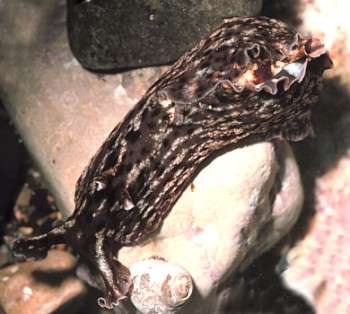
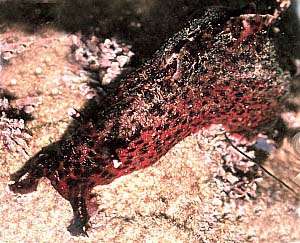
Aplysia californica
Cooper, 1863
Order: ANASPIDEA
Family: Aplysiidae
DISTRIBUTION
Most of the Californian coast and parts of the Gulf of California.
PHOTO
Flat Rock, Palos Verdes, Los Angeles, California, December 1993. PHOTOS: Daniel L. Geiger. See message below.
A very large Sea Hare, reported by MacFarland, 1966 to reach 75 cm in length, but usually about half that. Has become very valuable laboratory animal for research into nervous systems and brain behaviour.
See the General Topics List for more information on Sea Hares.
Reference:
• Cooper, J.G. (1863). On new or rare mollusca inhabiting the coast of California - No. II. Proceedings of the Californian academy of Science 3(1): 56-60.
Rudman, W.B., 1999 (March 12) Aplysia californica Cooper, 1863. [In] Sea Slug Forum. Australian Museum, Sydney. Available from http://www.seaslugforum.net/find/aplycali
Related messages
Aplysia californica? from Peru
June 3, 2010
From: Leonidas Mulluhara
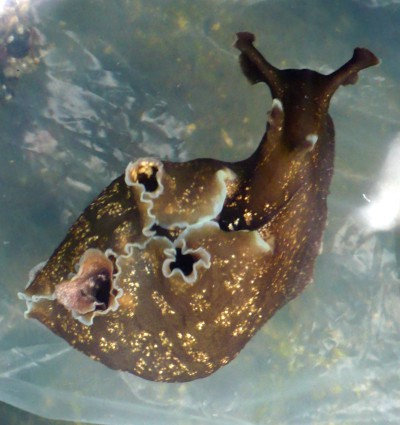
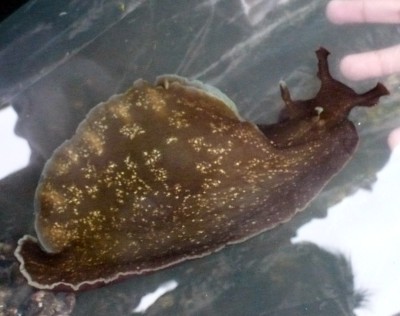
Dr. Bill,
Found this species in northern Peru. I´m not sure if its Aplysia brasiliana or Aplysia juliana.
I doubt that is Aplysia juliana because it has an ink gland which produces the characteristic reddish purple ink. Also this species eats Ulva.
Locality: beach, 1 and 7 m depth, Lambayeque, Peru, Pacifico ocean, 7 July 2008, rocky intertidal. Length: 194 mm. Photographer: Leonidas Mulluhara.
Your opinion will be very helpful.
Thank you
Leonidas Mulluhara
leo.keynote@gmail.com
Mulluhara, L.K, 2010 (Jun 3) Aplysia californica? from Peru. [Message in] Sea Slug Forum. Australian Museum, Sydney. Available from http://www.seaslugforum.net/find/23627
Dear Leonidas,
Yes I think we can eliminate A. juliana. As there are some opisthobranchs which occur on the Atlantic and Pacific coasts of South America I guess there is a possibility that your animal is part of the A. brasiliana - A. fasciata complex, but another possibility is that it is Aplysia californica. The furthest south I can find a record for is Costa Rica [Field Guide to the Sea Slugs of the tropical eastern Pacific], but that is not to say it doesn't occur further south.
Certainly the translucent whitish border along the edhe of the foot and the parapodia are reminscent of A. californica. It would be valuable to get some input from anyone with a more intimate knowledge of the species.
Best wishes,
Bill Rudman
Re: Sea of Cortez Mystery Slug
April 5, 2007
From: Jennifer Beatty
Concerning message #19781:
Wow, thanks for the info! I'm curious though - why do all of the Aplysia californica 's look so disimilar in coloring..is this a regional characteristic or is every sea hare different just like humans?
Jennifer Beatty
jlbeatty22@gmail.com
Beatty, J., 2007 (Apr 5) Re: Sea of Cortez Mystery Slug. [Message in] Sea Slug Forum. Australian Museum, Sydney. Available from http://www.seaslugforum.net/find/19815Dear Jenny,
Every animal is just a little bit different from every other one. That's essential for evolution to work. If every individual in each species was identical in colour, shape, physiology etc, then when environmental conditions changed every indiviudal in the species would be equally affected - and in the worst case the whole species would become extinct. What actually happens is that there are tiny differences between every individual and their parents. The differnec is not necessarily in colour, it could be in their ability to withstand a higher temperature, or perhaps digest their food a little more efficiently etc. These differences mean that when environmental conditions change a bit, some individuals in a species will be better able to adapt to the changes. In that way species gradually change into new species which are better able to meet the changed environmental conditions.
Best wishes,
Bill Rudman
Sea of Cortez Mystery Slug
April 4, 2007
From: Jennifer Beatty
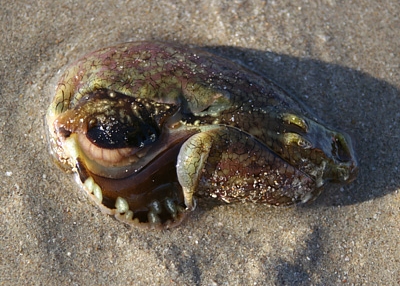
Hi!
I'd like to know what tide-pool slug I happened upon last weekend in Peurto Penasco Mexico - in the north eastern area of the Sea of Cortez.
It was pretty stormy and windy before we got there and there were quite a few animals on the beach in the morning, including this curious slug that was on its last leg when I got to him. We gathered him up with some water and sand and returned him to a nice calm tide-pool.
When I found him he was rolled up , possibly a defense mechanism? The outside or underside was the green and purple, however when we put him in the water he had the two distinctive slug antenae in the front and two auxilliary just behind those for a total of four.
He also opened up a bit to expose his other skin which is the brown with purple spots. He was pretty big, about the size hot dog bun rolled up and after he opened up, it seems like he might have been roundish in shape , like the size of a small saucer.
Just curious what he was and some characteristics about him - also is he the poisonous type?
Locality: Peurto Penasco, in tide pool, Sonora, Mexico, Sea of Cortez, 24 March 2007, Washed up on Intertidal Beach. Length: 8 inches. Photographer: Jennifer Beatty.
Jennifer Beatty
jlbeatty22@gmail.com
Beatty, J.L., 2007 (Apr 4) Sea of Cortez Mystery Slug. [Message in] Sea Slug Forum. Australian Museum, Sydney. Available from http://www.seaslugforum.net/find/19781Hi Jenny,
The animal you came upon is what is commonly called the California sea hare, Aplysia californica. The frontal pair of distinctive antennae, as you refer to them, are the head tentacles and the second pair are where this group gets the name "sea hare." Presumably they look like rabbit ears. Actually these are the rhinophores, or sensory organs used as chemo-detectors, for locating the algae species these very large slugs feed on.
When your critter "opened up" its was folding its large parapodia (extensions of the mantle) exposing the mantle cavity and internal organs. Sea hares are known to use these parapodia to swim with by flapping them like a bird. You can see its gill in your photo. It is the white layered crescent below the almost black tissue situated in the center of the cavity. Have a look at the Sea Hares Fact Sheet for links to more information on these animals
The color pattern of green and purple mottling is characteristic of Aplysia californica.
Best wishes,
Dave Behrens
Juvenile Californian Sea Hare & friends
December 12, 2006
From: Kevin Lee
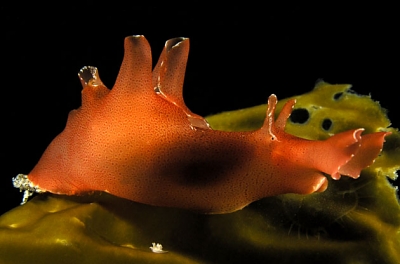
Hi Doc,
Just wanted to share these images of a juvenile California Sea Hare (Aplysia californica ). The coloration is so different from the adult, at first, I thought perhaps I'd bumped into an unknown (to me) species. However, Dave Behrens kindly confirmed it is indeed the Cal Sea Hare.
Locality: La Jolla Shores Canyon, Main Wall, circa 60 fsw, California, USA, Eastern Pacific, 28 OCT 2006, Sandy canyon wall, with kelp. Length: perhaps 2 cm. Photographer: Kevin Lee.
Then, to my pleasant surprise, when viewing the fotos in the comfort of my home, I was astonished to find what appears to be two other branchs on the kelp blade i.e. a Lion's Melibe (Melibe leonina ) and a tiny, nearly microscopic critter. The image resolution is so poor, ID is probably mission impossible. It was plenty dark and cold, so it's a wonder I even sighted the Hare...
Warm wishes for the Holiday Season!
K:-)
diverkevin@gmail.com

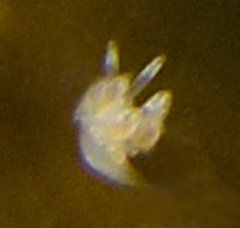
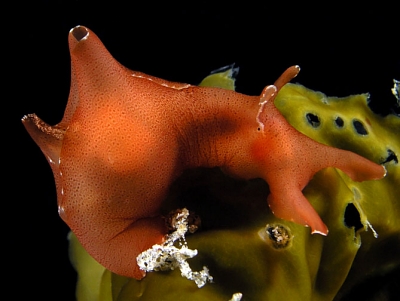
Dear Kevin,
Thanks for the best wishes and thanks for the photos. I wouldn't be surprised if the very little animal you photographed is also a juvenile sea hare. The flaps on each side of the body seem to be the beginnings of its parapodia. Of course I can't see its head so I could be quite wrong.
Best wishes,
Bill Rudman
Aplysia californica from California
May 17, 2006
From: Shannon Fabre

Hello!
I took these pictures for my oceanography photo project. I don't know what kind it is though. But I also included a picture of the area where I took it. Just thought I would share!
Locality: Ocean Beach, 1ft, California, USA, Pacific Ocean, 11 February 2006. Photographer: Shannon Fabre.
Thanks!
Shannon
shanny_kins@yahoo.com
Fabre, S., 2006 (May 17) Aplysia californica from California. [Message in] Sea Slug Forum. Australian Museum, Sydney. Available from http://www.seaslugforum.net/find/16570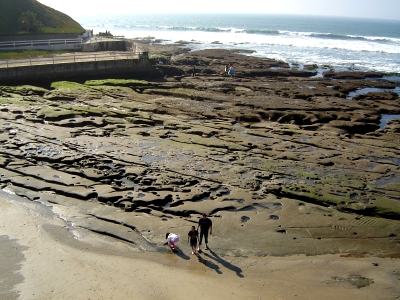
Dear Shannon,
I am sure your teacher will say it's good if you can identify the animals you photograph for your project. This is one of the common Sea Hares.in California, and not surprisingly its name is Aplysia californica. The rocky platform in your photo, with its crevices and pools, looks just the place to find interesting intertidal marine life.
Best wishes,
Bill Rudman
Aplysia californica from Sea Of Cortez
April 15, 2006
From: Gerald Hinkler
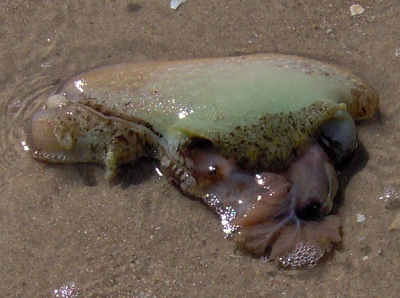
This creature was found in the tidal surf of El Golfo de Santa Clara, Sonora Mexico. I am interested in finding out what it is.
Locality: El Golfo de Santa Clara, Beach, Sonora, Mexico, Upper Gulf of the Sea of Cortez, April 7, 2006, Sandy surf, no waves. Length: Eleven Inches. Photographer: Gerald L. Hinkler, Jr., CPA.
Gerald L. Hinkler
ghinkler@yumaairport.com
Hinkler, G., 2006 (Apr 15) Aplysia californica from Sea Of Cortez. [Message in] Sea Slug Forum. Australian Museum, Sydney. Available from http://www.seaslugforum.net/find/16327Dear Gerald,
This is a sad photo of a Sea Hare washed up dead. I guess it is Aplysia californica. If you follow some of the links and earlier messages you will find quite a lot about Sea Hares on the Forum, and how they sometimes wash up in large numbers all around the world.
Best wishes,
Bill Rudman
Aplysia californica at Puerto Penasco, Mexico?
March 22, 2006
From: Parker Tastrom
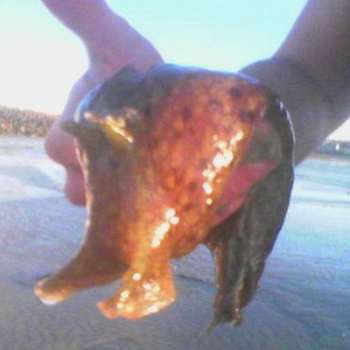
My friend and I found this on the shores of Rocky Point, Mexico during low tide. It was buried under the sand when we found it. I was wondering if it was in fact a seaslug and if not, do you know what it is?
Locality: Beach, a few inches, shoreline, Rocky Point (Puerto Penasco), Mexico, Gulf of California, March 13th 2006, Sandy. Length: 5 inches. Photographer: Parker Tastrom.
Parker Tastrom
pbowler31@hotmail.com
Tastrom, P.W., 2006 (Mar 22) Aplysia californica at Puerto Penasco, Mexico?. [Message in] Sea Slug Forum. Australian Museum, Sydney. Available from http://www.seaslugforum.net/find/16126
Dear Parker,
This is a Sea Hare which you will see from the Fact Sheet is a particular sort of Sea Slug. I suspect your animal is the large Aplysia californica.
Best wishes,
Bill Rudman
Juvenile Aplysia californica from Monterey, CA
July 8, 2005
From: Clinton Bauder
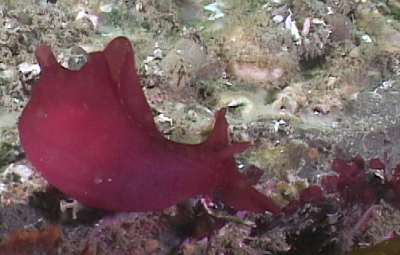
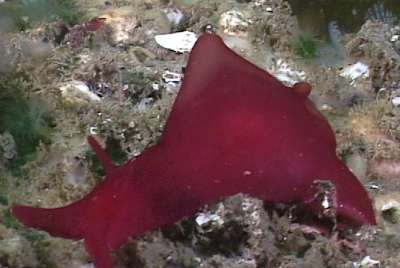
Hi Bill,
I was not sure about this one but was thinking a reddish Sea Hare from California is probably Aplysia californica. I asked Dave Behrens who confirms this and said:
"They are red like that when young. Probably because of juvenile diet".
This guy was on the shallow shale beds in Monterey at a depth of around 10 meters. Length was 3 or 4 cm. Again sorry for the mediocre images - video camers are great in a lot of ways but the resolution is a bit limited. If you look closely there are fine dark markings, especially on the front part of the animal.
Locality: Monterey, California, USA. Depth: 10 meters. Length: 3-4 cm. 03 July 2005. Photographer: Clinton Bauder
Sea Hares were common in Monterey a few years ago but have been rare recently. Not really sure why.
Clinton
gecko1@apple.com
Bauder, C., 2005 (Jul 8) Juvenile Aplysia californica from Monterey, CA. [Message in] Sea Slug Forum. Australian Museum, Sydney. Available from http://www.seaslugforum.net/find/14221Dear Clinton,
Nice to see some juvenile photos. Juveniles of quite a few Aplysia species feed on red algae when they first settle out of the plankton, and I see A. californica prefers Laurentia. I noticed in your upper photo that the animal is nosing around some little red algal plants remarkably similar in colour to it. They don't look like a species of Laurentia to me, but I don't think they feed exclusively on that species
Best wishes,
Bill Rudman
Can Aplysia californica eat kale?
March 5, 2005
From: John Lopez
Hello,
I am an undergraduate doing research on the behavioral feeding preferences of Aplysia californica at different developmental stages. I was curious to see if feeding the Aplysia kale as not to biase them to one of the foods to be tested, would be harmful to the sea hares? Also is there a site or would you happen to have any references to algal equivalents of kale in the ocean? I appreciate your help.
Thanks.
John Lopez
jdlopez1@panam.edu
J. Lopez, 2005 (Mar 5) Can Aplysia californica eat kale?. [Message in] Sea Slug Forum. Australian Museum, Sydney. Available from http://www.seaslugforum.net/find/13274Dear John,
There is a whole section of the General Topics index on Sea Hares including a list of references to feeding studies which you should look at.
The best source of information on mariculture and breeding, and I guess artificial foods, of A. californica is the NIH Aplysia breeding lab in Miami . [http://www.rsmas.miami.edu/groups/sea-hares/ ]
I know some people feed Aplysia with lettuce, which they blanch by quickly dipping the leaves in and out of boiling water, but I don't know how Aplysia would go with cabbage and its relatives.
Let us know how you go.
Bill Rudman
Information on Aplysia californica
February 8, 2005
From: Michael Navarro
Hi,
I'm a graduate student at CSU, Fullerton and I'm looking to contact individuals with the following information regarding Aplysia californica:
1) Culturing from all stages from egg to adult.
2) Field experience and knowledge of A. californica populations along the coast of Orange County, Ca.
3) Knowledge of temporal range of planktonic larvae. How long are the larvae planktonic?
If there is anyone who can help, it would be greatly appreciated.
Thank you,
Mike Navarro
michaelnavarro204@earthlink.net
Navarro, M.O., 2005 (Feb 8) Information on Aplysia californica. [Message in] Sea Slug Forum. Australian Museum, Sydney. Available from http://www.seaslugforum.net/find/13069Dear Mike,
You'll find quite a few references and messages on the Forum about this species but I guess the best source of information on mariculture and breeding is the NIH Aplysia breeding lab in Miami.[http://www.rsmas.miami.edu/groups/sea-hares/ ]
Best wishes,
Bill Rudman
Aplysia californica from Santa Barbara Island
June 30, 2003
From: Chris Grossman
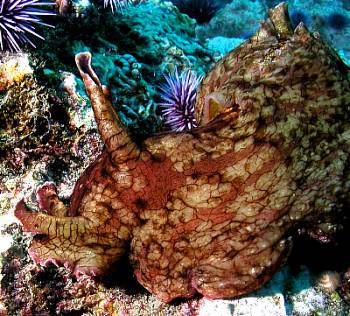
Dear Bill
Here are some photos I took of Aplysia californica at Santa Barbara Island, California, on Saturday, 7 June, 2003.
Chris Grossman
chris@diver.net
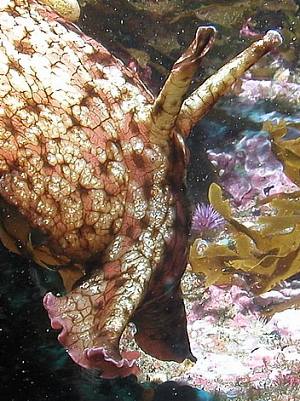
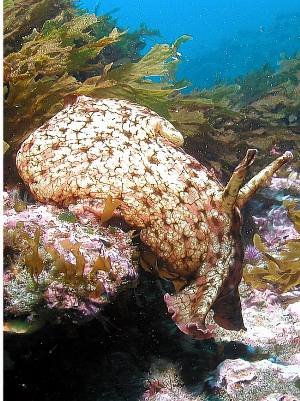
Thanks Chris,
Like most Sea Hares, we have few photos of this common animal. I guess when your organised for photographing small things, a large sea hare is just too difficult for most of us. It goes on the 'I must photograph this species some time' list.
Cheers
Bill Rudman
Re: Aplysia gigantea or A. californica?
March 3, 2003
From: Jun Imamoto
Dear Bill,
Thank you for your comment. The individual I photographed was behind a rock when I found it and when I tried to move it to measure its length it swam, but not very well. It got off the ground only for a very short time. From your comments I think this animal may be A. californica.
Best regards,
Jun Imamoto
http://umiushi.zive.net/
imamoto@wips.co.jp
Thansk Jun,
I would welcome the thoughts of those familiar with A. californica
Best wishes,
Bill Rudman
Aplysia californica inking
March 3, 2003
From: Bill Rudman
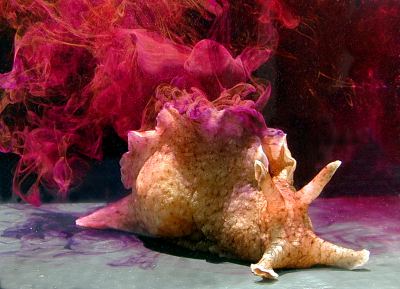
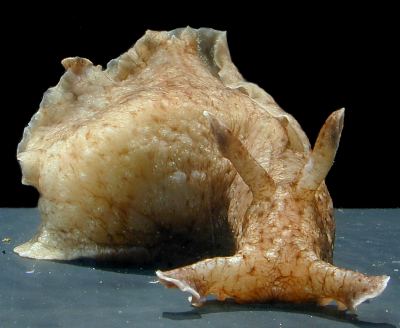
I have just discovered Genny Anderson's wonderful website at http://www.biosbcc.net/ocean/flindex.htm which she describes as 'a virtual trip to the Santa Barbara tidepools'. It contains an informative illustrated account of the Californian intertidal zone, including some excellent photos of various sea-slugs. Genny has given me permission to post a few of these photos on the Forum, including this spectacular photo of Aplysia californica inking. [see the Sea Hares - chemical defence Page for futher information].
Photos: A. californica, Coal Oil Point, Santa Barbara, California. Photos: Genny Anderson.
Genevieve Anderson
anderson@sbcc.edu
Biological Sciences Department,
Santa Barbara City College
Best wishes,
Bill Rudman
Aplysia gigantea? A. californica? from Japan
February 5, 2003
From: Jun Imamoto
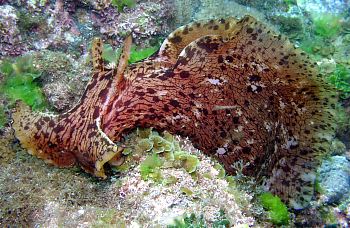
Dear Bill,
I think this animal from Hachijyo Island, Japan looks like Aplysia gigantea. Before I knew about this species from the Forum I had thought it was Aplysia californica because of the colour pattern of the body. I would be very happy to hear your comments.
Hachijyo Island, Japan. 29 June 2001. Size approx: 700mm. Depth: 3m. Temperature: 22C. Photos: Jun Imamoto
Best Regards,
Jun Imamoto
http://umiushi.zive.net/
imamoto@wips.co.jp
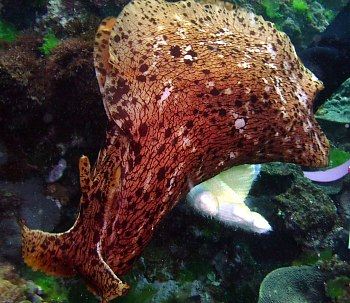
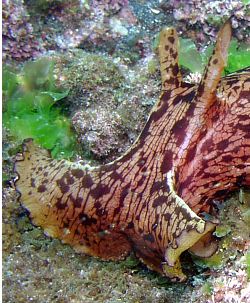
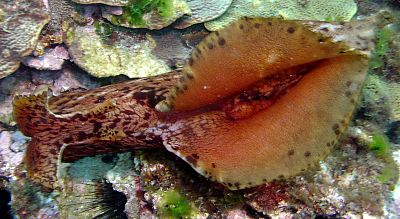
Dear Jun,
At 70cm long it is certainly is large enough to be A. gigantea, but MacFarland records A. californica growing to 75cm, so both identifications are a possibility on size. Did your animal swim? A. gigantea is a vigorous swimmer, but I don't think A. californica does. Sea Hares that don't have a distinctive color pattern, such as the rings in Aplysia dactylomela, are quite difficult to distinguish from one another externally. I suspect its no coincidence that all the species we consider to have a circumtropical distribution have distinctive colour patterns, while all those with nondescript colour patterns are considered to have quite local distributions. It is possible that A. gigantea and its Australian east coast congener, A. extraordinaria, are the same species, and possibly, so are other animals from elsewhere in the Indian and Pacific Oceans. Unfortunately they don't have good distinguishing characters. It would be interesting to know if your Japanese giant can swim. If it can't then perhaps it is A. californica. I would be interested in the opinions of our Californian colleagues.
Best wishes,
Bill Rudman
Which slug is used for medical research?
September 17, 2002
From: John H. Garrett III
Hello, could you tell me which slug feeds on Red Algae and is being used for medical research.
Thank you,
John Garrett
john7770@aol.com
Garrett, J.H., 2002 (Sep 17) Which slug is used for medical research?. [Message in] Sea Slug Forum. Australian Museum, Sydney. Available from http://www.seaslugforum.net/find/7959Dear John,
I suspect the slug you are thinking of is the Aplysia californica. It is bred in captivity for use in studies on how brains work. Like all Sea Hares it feeds on a variety of red, brown and green algae, but in captivity is fed on one of its favourites, the red alga, Gracilaria. Have a look at other messages on this page to find out more about this animal and the research that is being done with it
Best wishes,
Bill Rudman
Keeping Aplysia in aquaria
August 29, 2001
From: Jessica Helm
I feel like the answer to this must be on this site somewhere, but darned if I can find it. What temperature is ideal for keeping Aplysia californica non reproductive and content? Also is 4/ 20 gallon tank too many you think? Thanks for your many interesting messages and responses here. I'm glad so many people think they are as wonderful as I do.
PS: Aplysia remind me of the creatures on the grey planet in A Wrinkle in Time - soft, gentle, beautiful, sensing their way through a world where sight is unnecessary and touch speaks volumes.
Jessica Helm
jessica_helm@hotmail.com
Helm, J., 2001 (Aug 29) Keeping Aplysia in aquaria. [Message in] Sea Slug Forum. Australian Museum, Sydney. Available from http://www.seaslugforum.net/find/5149Dear Jessica,
Have a look at the website of the NIH-Aplysia Resource Facility in Miami, Florida. It is at: http://www.rsmas.miami.edu/groups/sea-hares/. You can download their online newsletter Slimelines. They are working on a much larger scale than you have in mind but you should be able to find some interesting background information there.
Perhaps you could send the Forum a summary of your research plan. I have had quite a few inquiries about keeping small numbers of Aplysia in captivity so if you have success in keeping them I would be grateful if you could send us 'the recipe' so I could post it on the Forum for other researchers.
Good luck for your project,
Bill Rudman
PS: While preparing this reply I sent an email to Tom Capo who is Resource Manager at the NIH-Aplysia Resource Facility asking for some advice on keeping small numbers of Aplysia. I have posted his almost instant response separately.
Rudman, W.B., 2001 (Aug 29). Comment on Keeping Aplysia in aquaria by Jessica Helm. [Message in] Sea Slug Forum. Australian Museum, Sydney. Available from http://www.seaslugforum.net/find/5149Re: Keeping Aplysia in aquaria
August 29, 2001
From: Tom Capo
Bill,
In answer to your question about "how to keep a few adult/subadult Aplysia alive and happy in aquaria until they are 'needed for science'":
Depending on the species , temperature is the most important factor.
Aplysia californica will do fine from 14-25 degrees C, while others, like A. brasiliana,
can handle higher water temps. Most are annual animals with egg production as their last important biological swan song! So if you start to get eggs they're on their way out. Cooler temps will delay spawning and extend their life. The salinity should be full strength 36ppt, less than 28 and it's all over. Romaine lettuce or sushi wrap can be used as food. They're easy to look after, grow fast and like to eat seaweed
Best Regards,
Tom Capo
NIH-Aplysia Resource Facility, Miami
TCapo@rsmas.miami.edu
Capo, T., 2001 (Aug 29) Re: Keeping Aplysia in aquaria. [Message in] Sea Slug Forum. Australian Museum, Sydney. Available from http://www.seaslugforum.net/find/5166Dear Tom,
Thanks for your quick reply.
Bill Rudman
Photos of Aplysia californica
August 1, 2001
From: Daniel Geiger
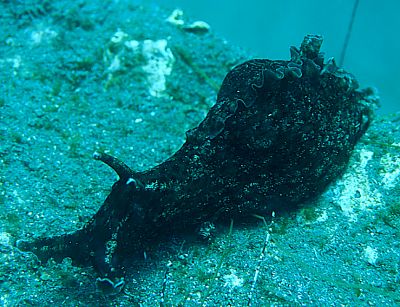
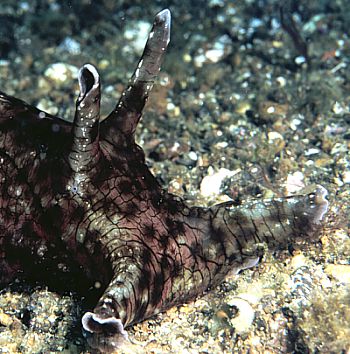
Dear Bill,
Here are some photos of Aplysia californica for the Forum. They were taken at West Anacapa Island, Channel Islands National Park, California, in 8-10 m., 5 July 2001. The animal was approximately 20-30cm long.
Best wishes,
Daniel Geiger.
dgeiger@nhm.org
Geiger, D., 2001 (Aug 1) Photos of Aplysia californica. [Message in] Sea Slug Forum. Australian Museum, Sydney. Available from http://www.seaslugforum.net/find/4983Thanks Daniel,
It's good to get some more photos of this famous animal. The photo of the head shows the pink, black, white and brown mottlings very well.
Cheers,
Bill Rudman
Mass mortality of Aplysia californica
March 24, 2001
From: Jose Luis Ochoa
I need your help: some recent events of mass mortality of Aplysia californica have occured in Bahía de La Paz, Baja California Sur, Mexico.
There are no clearcut reasons that explain these phenomena; since strandings of A. californica are uncommon, people are not really prepared to handle them. Children seem to like to play with specimens found still alive.
I wonder, do you have any idea about what is causing this? is it dangerous? should health authorities declare some caution or preventive measurements?
THANKS
Jose Luis Ochoa
jlochoa@cibnor.mx
Ochoa, J.L., 2001 (Mar 24) Mass mortality of Aplysia californica. [Message in] Sea Slug Forum. Australian Museum, Sydney. Available from http://www.seaslugforum.net/find/4025Dear Jose,
Have a look at the page on Mass Mortality in the Forum. Click on any of the underlined words to be taken to another relevant page. As you will see on that page there have been a number of these mass mortalities in Florida in the last few months. These are almost certainly 'natural' events caused by a combination of boom populations and severe weather events. If pollution was involved it would be very strange that only Sea Hares were affected.
As far as danger to people is concerned. Unless all the local marine life is being killed, Sea Hare deaths are unlikely to be the result of pollution. Sea Hares pose no known threat to humans so there is no likelihood of kids being in any sort of danger from handling them. Have a look at the general page on Sea Hares for some background information on these fascinating animals.
Best wishes,
Bill Rudman
Sea Hare classification - A. californica
December 31, 2000
From: Rachel Frank
Hi.
My name is Rachel Frank, and I am a student at Millikan High School in Long Beach California, and I am doing a report on Sea Hares. I need to know the classification (Kingdom, Phylum, Family, Genus, species) of the Aplysia californica, and I was wondering if you could help me. I was also wondering if you could tell me if I would be more likely to see Aplysia californica or Aplysia vaccaria in Catalina, California (we are going in January as part of this project)
Thanks for your Help
Rachel Frank
RachyFrank@aol.com
Frank, R., 2000 (Dec 31) Sea Hare classification - A. californica. [Message in] Sea Slug Forum. Australian Museum, Sydney. Available from http://www.seaslugforum.net/find/3420Dear Rachel,
Have you had a look at the pages on the Forum about sea hares? If you go to the Sea Hares Page you will a list of other useful pages. If you click on any underlined word it will take you to a page about that subject.
On your question about its classification. Aplysia califoornica belongs to the Animal Kingdom. It is a peculiar sort of snail which is losing its shell, and ii related to other snails and clams and octopus. It therefore belongs to the Phylum Mollusca. It is a Sea Hare, which is a special group of sea slugs belonging to the Order Anaspidea, and it is in the Family Aplysiidae. The name, Aplysia californica, answers the last part of the question about what Genus and species it belongs to.
An animal's scientific name, in this case Aplysia californica, is its species name and it always consists of two words. The first word, with a capital letter at the front is also the Genus name. So the genus is Aplysia. If anyone tells you that the species name is just californica they are wrong, it is Aplysia californica.
Now to your more interesting question about which species you are likely to find. I am afraid that living in Sydney, Australia, I don't have much knowledge of your Californian sea hares. However I am sure someone in California will read your message and either send some information to the Forum or write to you directly. So keep looking at the Forum for a few days to see what messages other people send in about Californian sea hares.
Good Luck with your trip to Catalina,
Bill Rudman.
Aplysia for brain studies
September 2, 2000
From: Alvin Wong
Hi, my name is Alvin Wong.
I was wondering what the best species of Aplysia to work with for experiments involving synaptic plasticity was. Also, how can one keep Aplysia alive in a classroom?
Thank You,
Alvin.
alwongnet@aol.com
Dear Alvin,
Am I right in assuming you live in the USA? If so Aplysia californica is probably the way to go as it is the standard species used in this research in the US. There are also commercial suppliers.
Have a look at the messages below yours on this page for more information on the subject and for the address of suppliers. I am not a great expert on keeping Aplysia alive for long periods of time and am nor sure on what scale you plan to operate. If it's one or two animals, they should not be that difficult to keep as long as you have a good circulation system or filtration system and source of algae for them to eat. I do remember a message to the Forum by someone suggesting they quite like eating lettuce.
If you plan to buy some I am sure the suppliers will be able to give you some basic advice on keeping them alive. Also use the SEARCH button (type in brain or learning) as there are other messages on the general Sea Hare pages.
Best wishes,
Bill Rudman.
Information on Aplysia californica
April 20, 2000
From: Luiza Zonzini
Hi,
I'm Luiza Zonzini, a Brazilian student, and my school is developing a project called INVERTBAND2000 and i'm supposed to work on Aplysia californica. I'm almost finishing my work but I couldn't find an objective information about habitat, habits and I couldn't quite understand how do they eat. I would be very glad if you could answer me before April 21st.
Luiza
lucarvalh@hotmail.com
Zonzini, L., 2000 (Apr 20) Information on Aplysia californica. [Message in] Sea Slug Forum. Australian Museum, Sydney. Available from http://www.seaslugforum.net/find/2296Dear Luiza,
I am surprised the Aplysia you are investigating is Aplysia californica. It is from the west coast of North America. You should be looking at your own Aplysia brasiliana.
There is a lot of information on Sea Hares in the Forum. Have a look at the What is a Sea Hare? Page for information. At the top of each page you will find a picture and background information. Make sure to look further down the page for messages and comments which also contain more information. There is also a page on Aplysia californica.
Have a look at the message which has a picture of Aplysia californica's mouth and talks about feeding. Also have a look at my answer to another message asking about what Aplysia californica ate.
There is also a description of the gut of another Sea Hare, Bursatella, which is very similar to that of Aplysia. If you want to compare feeding in Sea Hares (which feed on plants) with feeding in a dorid sea slug which feeds on animals have a look at the page on feeding organs in dorid nudibranchs.
I am not sure if you use the internet a lot. In case you don't know, if you click on the coloured and underlined words in this message, you will go to those pages. To get back to this message just click on your BACK button. I hope this will be of help.
Good luck with your INVERTBAND2000 project.
Best wishes,
Bill Rudman.
Re: HUGE Sea Hare
December 15, 1999
From: Ron Velarde
Dear Diane,
Your specimen is Aplysia californica. This species commonly exudes the purple ink when irritated or disturbed. The second species from southern California, Aplysia vaccaria does not produce purple ink.
And Bill,
The new format is even better than before!
Ron Velarde
P.S. Sorry, I don't have photos of A. vaccaria.
rgv@sdcity.sannet.gov
Velarde, R., 1999 (Dec 15) Re: HUGE Sea Hare. [Message in] Sea Slug Forum. Australian Museum, Sydney. Available from http://www.seaslugforum.net/find/1675Thanks Ron,
Glad you like the format, and thanks for the useful bit of information on separating the two species. I'll put a note on the Aplysia vaccaria page.
Best wishes,
Bill Rudman.
Re: HUGE Sea Hare
December 10, 1999
From: Diane
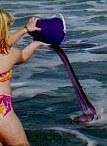
Dear Bill,
Thank you for your reply!
Attached is a pic of the purple-ink that the Sea Hare emitted into the bucket....
Diane.
Is this a sea slug? It's HUGE!!
December 9, 1999
From: Diane
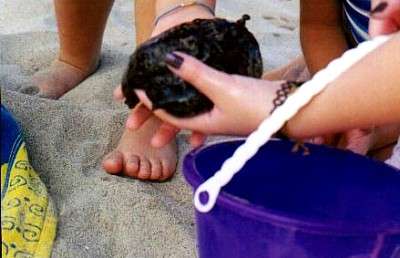
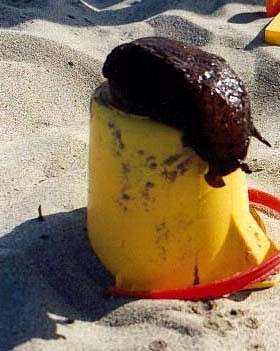
I am hoping you can tell me what this 'creature' is...
My children found in the shallow water on the Beach in Malibu, California, on Labor Day weekend. I think it must have emitted a 'dye' of some sort... because when they put it back in the ocean... the water in the bucket was a bright glowing purple!
Diane
Dear Diane,
Yes this is a sea slug. It belongs to a group of sea slugs we call Sea Hares, many of which produce reddish or purple ink when disturbed. You will find lots more information on Sea Hares in the Forum by going to both the Sea Hares Page and the page on Sea Hare defence. On the top of each page is some background information and below that there are messages and answers about the topic. Have a look at those because there is usually more information there.
Your animal is either Aplysia californica, whch grows up to 75 cms long, or Aplysia vaccaria, which grows to about about 100 cms! Both live in California and both can be this dark colour. Perhaps a Californian can identify the species of your animal for us.
Best wishes,
Bill Rudman.
Sea Slugs from South California
July 13, 1999
From: Lonnie
We have recently found a sea creature that appears to be a slug. It has a mostly round shape, brownish in color with several black spots one possibly a mouth? It was left behind at low tide near our sea wall. I would like to get to know if it is a slug as my children are afraid that it might be an extra large parasite or a leech which I am sure it is not. We live in Huntington Harbour in Southern California. The size is approximately 4" in diamater and more oval than round and does not have a tail. Underneath is has a main suction type area surrounded by flapish body (similar to the look of a ray.
If it is at all possible for you to reply by Email so I can put my children at ease and now satisfy my own curiousity I would greatly appreciate your time. We also have an abundance of jelly fishes at this time.
Looking forward to your response.
Lonnie
LGialketsi@aol.com
Gialketski, L., 1999 (Jul 13) Sea Slugs from South California. [Message in] Sea Slug Forum. Australian Museum, Sydney. Available from http://www.seaslugforum.net/find/1052Dear Lonnie,
I'm afraid I'm not an expert on Californian marine life but it is likely that your animal is a Sea Hare. The 'flappy' bits could be the parapodia on each side and the 'suction type area' could be the foot. Have a look at the page on Aplysia californica and the page on Sea Hares and read some of the messages on those pages for more information. If it is a Sea Hare they are quite safe to pick up. They may squirt out some red purple inkwhich is another good indicator that you have a Sea Hare.
Best wishes,
Bill Rudman.
re: Need to know what we saw
July 12, 1999
From: Eileen Steger
THANK YOU VERY MUCH FOR YOUR RESPONSE. I did find more info as I looked through the website.
Thanks again,
Eileen
eileen.steger@Sun.COM
Re: Sea Hares - mating chains
July 12, 1999
From: Sigrid Schmalzer
Dear Bill,
Thanks for your message. I don't have a photo of Aplysia vaccaria right now, but I'll try to remember to bring a camera next time I hit the tide pools.
Sigrid
sschmalz@ucsd.edu
Dear Sigrid,
Look forward to your photos
Bill Rudman.
Re: Sea Hares - mating chains
July 9, 1999
From: Sigrid Schmalzer
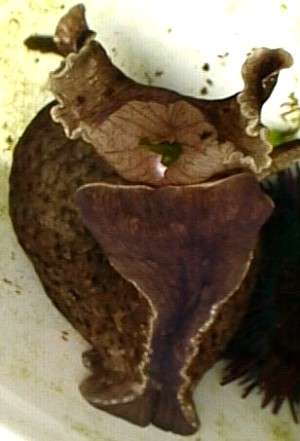
I am a volunteer at the Birch Aquarium in La Jolla, California (affiliated with the Scripps Institution of Oceanography) where I provide interpretation at the touch tanks. The California Sea Hares (Aplysia californica) in one of the tanks were mating today. Their position was very similar to that of the Sea Hares in the photos supplied by Erwin Koehler. I was amazed by how long they remained engaged -- several hours at least. They were not disturbed by gentle touches by the visitors, and the sea hare receiving sperm continued to "beg" and feed on Ulva (sea lettuce) offered by visitors.
Regarding the begging behavior, the Sea Hares placed in the touch tanks learn quickly that food comes from above. When tickled lightly on the head, they wave their heads and even open their beautiful mouths to receive Ulva (see photo). The wild Sea Hares I have found in nearby La Jolla Cove do not react at all to this kind of stimulus.
Despite their reputation for being fragile, the California Sea Hares do very well in the touch tanks. (Of course, we're very protective of them and ensure they're treated respectufully.) I have watched several grow from finger size to forearm size in the tanks.
This is a very good year for Sea Hares in this area. Visitors to La Jolla Cove have had a very easy time finding the Black Sea Hares (Aplysia vaccaria), and I found one California sea hare on my last visit.
Sigrid.
sschmalz@ucsd.edu
Schmalzer, S., 1999 (Jul 9) Re: Sea Hares - mating chains. [Message in] Sea Slug Forum. Australian Museum, Sydney. Available from http://www.seaslugforum.net/find/1038Dear Sigrid,
Thanks for the interesting information on Sea Hares and the great photo of Aplysia with a mouthful!. By coincidence I have just had an enquiry from Eileen Steger about a 'black football-shaped' animal washed up on the beach in California which I guess is Aplysia vaccaria. If by chance you have a photo of Aplysia vaccaria it would be nice to be able put one on the Forum.
I have never heard of anyone 'training' Sea Hares like this for touch tanks, but obviously their use for scientific studies in learning and brain function suggests they can be taught simple things. As I'm sure you know, touch tanks are a great way for kids (and parents) to experience and discover why we find marine life so fascinating.
Best wishes,
Bill Rudman.
Need to Know what we saw
July 8, 1999
From: Eileen Steger
I was vacationing in Capitola, California over the July 4th long weekend. On the beach there was a lot of seaweed and also this sea creature I have never ever seen before.It was black and as big as a football I would estimate. When we tried to push it back in it put out some purple ink. Also its head emerged and these antenna looking things came out. I have never ever seen this before and want to know what it is. Is is harmless. Would it sting like a jelly fish if you
stepped on it.
Again, it was black and the size of a football and it was just this big fat blob of stuff and it was with a lot of seaweed.
Thank you in advance for any info you may have.
PS. We saw two of them on two different days. Another person saw four of them
Eileen
eileen.steger@sun.com
Dear Eileen,
Your animal sounds like a Sea Hare. Your animal is probably Aplysia vaccaria which is found in California, is often black, and can grow up to about 1 meter long! I'm sorry I haven't a photo of it but there are photos of other species of Sea Hare in the Forum which you can find if you look in the Sea Hare Species List.
Many Sea Hares produce purple ink when they are squashed or irritated. Sea Hares feed on sea weeds. Some live on rocky coasts and others on sand or mud in quiet bays and inlets where there is not much water movement. Sometimes you find them washed up on beaches as you have done. This usually means they are dying or have been washed in from deeper water after storms.
There is a lot of information on Sea Hares in the Sea Slug Forum. If you go to General Topics Page and go down the list until you reach Sea Hares you will find quite a few pages with interesting stuff on animals like your 'black football'.
They are not dangerous.
Best wishes,
Bill Rudman.
Photos of Aplysia californica
March 12, 1999
From: Daniel Geiger


Dear Bill,
As promised, here are some photos of Aplysia californica. They were photographed by me at Flat Rock, Palos Verdes, Los Angeles, California, December 1993.
Daniel.
Daniel L. Geiger
Dept of Biological Sciences
University of Southern California
Los Angeles,
CA 90089-0371
USA
http://www.sbnature.org/geiger
dgeiger@usc.edu
Geiger, D., 1999 (Mar 12) Photos of Aplysia californica. [Message in] Sea Slug Forum. Australian Museum, Sydney. Available from http://www.seaslugforum.net/find/670Dear Daniel,
Thanks for your help with these photos and the ones of Hypselodoris zebra.
Best wishes,
Bill Rudman.
Urechis caupa or Aplysia californica
February 26, 1999
From: barbara hansen
Do you have any pictures of these? I found the worm when clam digging at Bodega Bay, California. The worm looked like a sausage, the slug had purple fluid coming from it, they were very interesting.
Thank you,
Barbara
barbarah@vom.com
Hansen, B., 1999 (Feb 26) Urechis caupa or Aplysia californica. [Message in] Sea Slug Forum. Australian Museum, Sydney. Available from http://www.seaslugforum.net/find/615Dear Barbara,
I'm afraid Californian worms, even interesting Echiurid worms, are not something I have photographed. At the moment I don't have a photo of Aplysia californica, but if you have a look at the "Sea Hare" topics listed in the GENERAL TOPICS index, you will find pictures and information on many other Sea Hares and also on the purple ink they produce.
Best wishes,
Bill Rudman.
Aplysia californica algal preference
January 3, 1999
From: Christine Nguyen
Dear Bill,
My name is Christine Nguyen and I am a marine biology student at Long Beach Polytechnic High School in California. For an individual research project, I am going to survey the amount of sea hares in one particular area of a tidepool in relationship to the percentage of different types of algae by using a 4 meter quadrat to then determine the sea hares' food preference in the different types of algae. I'm not finding much luck in finding information regarding algae preference, so do you have any recommendation as far as how I should go about starting my project as well as any information regarding the food preference of sea hares through research?
Your help is greatly needed and appreciated.
Thank you for your time.
Sincerely,
Christine Nguyen
Ctngirl@aol.com
Nguyen, C., 1999 (Jan 3) Aplysia californica algal preference. [Message in] Sea Slug Forum. Australian Museum, Sydney. Available from http://www.seaslugforum.net/find/432Dear Christine,
I guess the sea hare you are looking at is Aplysia californica. I'm afraid I am not an expert on Californian sea slugs but if you have access to either of Kandel's books, or the article which I list below you will get some background reading. Aplysia californica is now an important research animal in behaviour and learning studies and so there are many published articles on it. have a look at the website I mention in a message below of the NIH-Aplysia Resource Facility in Miami, Florida. I think the site has just been updated. It is at: http://www.rsmas.miami.edu/groups/sea-hares/. In their online newsletter Slimelines Vol 2, they discuss research on feeding Aplysia californica. However they are feeding their animals on a red algae which doesn't occur in California.
In their natural environment, Aplysia californica change their food as they grow. They normally settle out of the plankton onto red algae (often Laurencia) and then gradually move higher up the shore where they feed on brown and green algae. This is a pattern followed by species of Sea Hare throughout the world. I suspect any study you do would need to take into account the size of the Sea Hares you are counting. Since they change their food preference as they grow you would have to separate them into size groups to make any sense of your observations. However it is not just a simple change of diet once a certain size is reached because they will eat other than the preferred food if it is not available. If you look at the website on the group who are breeding Aplysia californica they feed their animals on a red algae Gracilaria for their whole life - and its a species of algae that the Sea hare would never find naturally.
Concerning the identification of algae. I am sure there must be a good book which you could use. My suggestion is that you get in touch with your local Natural History museum or see if a Botany or Biology dept at a local University can't give you some help. Surfing the web can be very useful but so can making contact with local experts.
Please let me know how your study turns out,
and if anyone in California who reads this can give Christine advice please do.
Best wishes,
Bill Rudman.
References:
Kandel,ER (1979): Behavioural Biology of Aplysia. San Francisco, W.H.Freeman&Co.463pp.
Kandel,ER (1976): Cellular Basis of Behaviour. An introduction to behavioural neurobiology. W.H.Freeman & Co., San Francisco. 727 pages.
Stallard,MO; Faulkner,DJ (1974): Chemical constituents of the digestive gland of the sea hare Aplysia californica - I. Importance of diet. Comp. Biochem. Physiol. 49 B, 25-35.
Rudman, W.B., 1999 (Jan 3). Comment on Aplysia californica algal preference by Christine Nguyen. [Message in] Sea Slug Forum. Australian Museum, Sydney. Available from http://www.seaslugforum.net/find/432Photo request for Aplysia californica
August 3, 1998
From: Panayotis Matsinopoulos
Dear Dr.Rudman,
I am trying to accomplish a small article on neurology experiments on behalf of the magazine Metro, in Greece. Metro is a general purpose magazine.
I know that sea slugs are used in experiments in medicine and I came across with a specific species which is the Aplysia californica. It would be very useful for the readers to have a picture of the referred sea slug.
I was wondering if you have a picture of Aplysia californica and if you allow Metro to use it as an illustration. Of course, your name will be quoted as the source of this particular picture.
Thank you very much in advance
Yours sincerely,
Panayotis Matsinopoulos
Panos.Matsinopoulos@mailcity.com
My current address is
P.Matsinopoulos
Langton Close Hostel
Wren strt
London WC1 X0HD
U.K.
My home address is:
Panayotis G. Matsinopoulos
70 Megistis strt.
GR-11364 Athens
Hellas
Panos.Matsinopoulos@mailcity.com
I'm sorry I don't have photos of the species you are interested in but I perhaps someone visiting the Sea Slug Forum from California can help you.
Another possibility is Daniel Gardner, Cornell University Medical College, who hosts the Aplysia Home Tank site .. Bill Rudman
